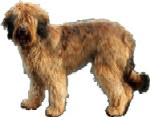
Our Views on Owning a Briard
The Briard is a large gallumping French fur ball sheepdog which can trace its history back to at least AD 800. Briard populations have barged their way across Europe, into Australia and are strong in the USA. A good article on USA Briard’s can be found here: http://www.k9web.com/dog-faqs/breeds/briards.html by Dianne Schoenberg a respected Briard authority. There are differences between how the USA crop Briard’s ear while we in Europe do not, other than that the article is highly informative. If you haven’t owned a Briard before it is worth a read – but not before you’ve read our ‘on the job’ thoughts.
Owning a Briard.
Herding
A Briard’s urge is to herd; you, your family, your friends and your other pets.
Crutching
They also like to ‘Crutch’ their ‘friends’; 100lb of galloping fur will hurtle across a room knocking whatever out of the way – including your children and best furniture - to jam their nose hard into an unsuspecting and unprotected nether region; then while their victim is in shock, rear up bear like on their hind legs, trapping their victim between their front paws and then lick the nose right off their face!
Owning a Briard is fun and you should be able to look forward to 10 to 12 years of out-sized ‘hearts wrapped in fur’ Briard gestures. Still want to own a Briard? Good, then read on.
Colour
First of all you need to decide on colour and sex. Briard’s come in shades of fawn, grey, black, or a combination of those colours. Millie on our home page is a good example of a fawn Briard while Sophie is a good example of a Black Briard. A black Briard can have fine streaks of white running through it. That’s colour out of the way.
Which Sex?
That’s down to you. We keep 2 bitches together and they are fine; we haven’t put males together – we’d never get anything done, they would spend too much time barking about it. If you have a bitch there is of course the chance of pups or with a male a stud fee. Males are a shade larger 23-27 inches – bitches 22 to 25.5 inches - and of course the males enjoy crutching more. Ben – our male who sadly passed away in 2007 – would wait for a victim to bend down to place something in the bin, then he would pound over, whoosh; launch himself fully at the exposed rear end to send the person sprawling. Then he would happily flop down on the victim to slurp wetly at the struggling face. Oh yes and he liked to wrestle, not a trait shown by our bitches over the years.
Health?
What ills can befall your Briard? Night blindness – we suffer from this, so do horses and Briard’s. Hip dysplasia – where the hip ball and socket joint is out of line which as time goes by will cause your Briard discomfort and pain. A good reliable breeder – will make sure that a breeding pair is clear of night blindness and hip dysplasia. Dogs are tested for these genes and certificates are issued. In our opinion dogs should not be breed from if they are not clear of these conditions. Neither should you buy a puppy if any one of the parent is not clear. An unscrupulous breeder might tell you it doesn’t matter, but it does very much. If you care about your dog and the future of the breed then at all costs avoid pups from those types of breeder. Link to the full article by Dianne Schoenberg or our extracted health section Briards Health